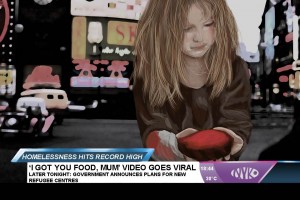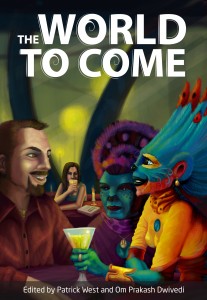
In a recent interview on ABC Radio National’s Books and Arts Daily, Nic Low, an Australian author who has just published his first collection of short stories, Arms Race (Text Publishing) argues that 89% of short fiction produced in Australia is middle class white angst and not really ‘about anything’. In this special blogpost, CAITLIN WALLACE writes about The World To Come anthology and argues that the important themes and issues raised by its twenty-one authors challenge Low’s critique.
I would strongly disagree with this statement on the whole, however, I think once presented with The World To Come, the latest anthology of short stories published by Spineless Wonders, with its stories about apartheid in South Africa, racism in Australian Indigenous, global warming, genocide and militarization, Nic Low would have no trouble placing this book in the other 11% of short fiction. The stories in The World To Come, edited by Patrick West and Om Prakash Dwivedi, are most definitely about things – about issues and behaviours of concern to us here and now.
The topic of ‘The World to Come’ is a broad one and one which lends itself to a wide range of speculation and scenarios. Of course, most of the stories in this anthology are set in the future, however it is a refreshing change when a story is more clearly in our time period, or has a more ambiguous time setting. As editors, West and Dwivedi say in their introduction, ‘Here are twenty-one visions of the future, sometimes presented through the past.’ In all twenty-one stories there is a diverse mixing and blending of genres from Science Fiction, Speculative Fiction, Realism, Fantasy and stories that are such an equal blend of genres it renders them impossible to categorize.
The first story in the collection ‘A Part Hide, A Part Human’ by Craig Cormick is one of the stronger stories in this set, with it also being the inspiration for the lurid, futuristic colors of the cover art. Simply saying the title out loud provides the reader an insight into what this piece of short fiction will be about. Apartheid. And while the discrimination and ostracism in Cormick’s futuristic South Africa is between humans and a trans-genetic species who are part human and part animal, South Africa’s history of racial apartheid is a clear subtext of his story.
Many of the stories carry warnings about our future, based on what writers see is already happening around them. Emily Riches, one of the contributors and a participant in the Spineless Wonders online bookclub discussion of The World To Come, describes reading Dirk Strasser’s 2084 with ‘a shock of recognition’. She says, ‘Wikipedia and individual editing of information is happening now and what Strasser does is exaggerate this somewhat in order to alert you to real-life dangers and implications – an individual’s control over ‘facts’, the story goes to show, is in effect, can control over lives.’
Whilst the stories in this anthology are all linked by the theme of looking to the future, there is a wide diversity of subjects and issues explored under this general heading. Time periods changes dramatically from piece to piece with some works being set believably in the present, while some only a stone’s throw away, such as in Leone Ross’s ‘Fix’ which is set in 2035, and some set a millennia after most of human kind has died out such as in John G. Shulman’s ‘Progress’. Themes in these stories range from the rewriting of history, over-sexualisation of women, colonialism, global warming, religion, nature reclaiming the earth, repopulating the earth and misplaced faith in militarism. A lot of these stories are negative about the implication of the future with many occurring after a post-apocalyptic events – from the drying up the water supply, viruses killing off large amounts of the population, a large being in the sky destroying all technology and coating the world in dust – yet the writers still manage to weave tales that are not outright depressing, but thought-provoking. In the story ‘Awake’ by Ben Brooker one of the characters simply says, ‘It’s not the apocalypse we were supposed to have.’ It is well-written statements like these that allow for discussion on the broader themes evident in the writing.
The topic of the pessimistic outlook of many of the stories in the anthology was also discussed on the bookclub. Host, Evelyn Araluen Corr posed these discussion questions, ‘So what is it we find so addictive about these dark predictions for our future? Are they a way for us to play out our deepest fears and anxieties so the future is not so unknown (better to know your enemy)? Or is there something masochistic about it? Does it, as I believe, give us hope?’ Dirk Strasser defended the apocalyptic themes of the anthology. ‘Science fiction is often criticised for presenting the future as a bit grim,’ he says, ‘but utopias make boring stories. There’s no conflict. Dystopias offer so many dramatic possibilities. There’s always so much at stake. They are a great setting for fiction.’ Joe Tham added that she thought dystopian fiction is ‘both radical and conservative in nature, not only a means of exploring new possibilities, but also of reaffirming the current social structures.’ Another interesting viewpoint raised was that while we often look at an apocalypse as awful for humanity, often times this can be good for the planet, which is a theme explored in ‘Into the Stillness Came the Rain’ by Crisetta Macleod.
The theme of the unreliable narrator was brought up as being present in this anthology, and in true fashion of someone who works for a publisher, Evelyn Araluen Corr strongly asserts, ‘We’ll know we’ve gone too far when they burn down the libraries.’
The last work in the anthology, ‘Gamil Yanaay Walaybaa: No Going Home’ by Marcus Waters is a wonderful piece to round out the anthology exploring as it does the past, present and future as well as the idea of resurrection through Indigenous Australian spirituality. This work also discusses the chilling implications of police brutality, yet the story (and anthology) finishes on a somewhat more inspiring note about how technology is being used to document police brutality and making these actions more available to the public.
Watch The World To Come booktrailer, designed by video artist, Evelyn Araluen Corr, here.
Caitlin Wallace is currently lost between adolescence and adulthood, and spends far too much time reading, watching anime and planning out her actions for a zombie apocalypse. You can send her suggestions for any of these aforementioned hobbies on twitter.
